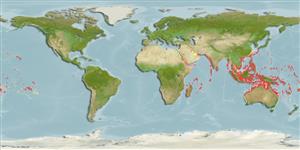>
Kurtiformes (Nurseryfishes, cardinalfishes.) >
Apogonidae (Cardinalfishes) > Apogoninae
Etymology: Cheilodipterus: Greek, cheilos = lip + Greek, di = two + Greek, pteryx = fin (Ref. 45335).
More on author: Lacepède.
Environment: milieu / climate zone / profondeur / distribution range
Écologie
marin récifal; profondeur 0 - 100 m (Ref. 9710), usually ? - 30 m (Ref. 11441). Tropical; 30°N - 35°S, 25°E - 133°W
Indo-Pacific: Red Sea and East Africa (Ref. 8525) to Pitcairn, north to the Ryukyu Islands, south to Lord Howe Island and Rapa.
Taille / Poids / Âge
Maturité: Lm ? range ? - ? cm
Max length : 25.0 cm TL mâle / non sexé; (Ref. 11441)
Épines dorsales (Total) : 7; Rayons mous dorsaux (Total) : 9; Épines anales: 2; Rayons mous anaux: 8. Characterized by having dorsal fin rays VI-I, 9; anal fin rays II,8; pectoral fin rays 12; pelvic fin rays I, 5; pored lateral line scales 25; predorsal scales 6; circumpeduncular scales 12; large canine-like teeth on jaws; preopercular margin serrated (Ref. 93839).; juveniles have a large black blotch on the caudal peduncle which becomes diffuse with age. Adults resemble adults of C. artus, but have wider stripes with darker interspace (Ref. 37816); characterized further by pale grey color; eight red-brown stripes on side, caudal fin base whitish; dark caudal fin margins; greatest depth of body 3.1-3.8 in SL (Ref. 90102).
Body shape (shape guide): short and / or deep; Cross section: compressed.
Common in outer reef slopes in 4-30 m depth; in caves and ledges of clear lagoon and seaward reefs from 0.5 to at least 40 m, generally hovering solitarily in midwater (Ref. 1602). Adults usually in pairs or small groups comprising several pairs; juveniles solitary or small groups (Ref. 48635). Feeds primarily on small fishes (Ref. 9710). Sexual maturity reached at about 8 cm. Maximum depth reported taken from Ref. 128797.
Life cycle and mating behavior
Maturité | Reproduction | Frai | Œufs | Fécondité | Larves
Mouthbrooders (Ref. 240). Distinct pairing during courtship and spawning (Ref. 205). Displays obligate monogamy where a one-to-one pair is established irrespective of resource abundance (Ref. 52884).
Gon, O., 1993. Revision of the cardinalfish genus Cheilodipterus (Perciformes: Apogonidae), with description of five new species. Indo-Pac. Fish. (22):59 p. (Ref. 8525)
Statut dans la liste rouge de l'IUCN (Ref. 130435: Version 2025-1)
Menace pour l'homme
Harmless
Utilisations par l'homme
Outils
Articles particuliers
Télécharger en XML
Sources Internet
Estimates based on models
Preferred temperature (Réf.
123201): 24.7 - 29, mean 27.8 °C (based on 1114 cells).
Phylogenetic diversity index (Réf.
82804): PD
50 = 0.5000 [Uniqueness, from 0.5 = low to 2.0 = high].
Bayesian length-weight: a=0.01175 (0.00709 - 0.01948), b=3.18 (3.04 - 3.32), in cm total length, based on LWR estimates for this species & (Sub)family-body (Ref.
93245).
Niveau trophique (Réf.
69278): 4.1 ±0.61 se; based on food items.
Résilience (Réf.
120179): Milieu, temps minimum de doublement de population : 1,4 à 4,4 années (Preliminary K or Fecundity.).
Fishing Vulnerability (Ref.
59153): Low vulnerability (15 of 100).
🛈
Nutrients (Ref.
124155): Calcium = 66.1 [33.7, 114.0] mg/100g; Iron = 0.638 [0.370, 1.043] mg/100g; Protein = 19 [18, 20] %; Omega3 = 0.124 [0.076, 0.197] g/100g; Selenium = 29.8 [17.0, 56.1] μg/100g; VitaminA = 59.1 [17.9, 189.2] μg/100g; Zinc = 1.02 [0.70, 1.49] mg/100g (wet weight);
